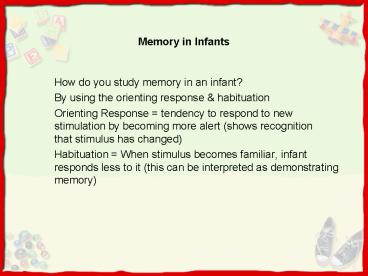Memory in Infants - PowerPoint PPT Presentation
1 / 27
Title: Memory in Infants
1
Memory in Infants
- How do you study memory in an infant?
- By using the orienting response habituation
- Orienting Response tendency to respond to new
stimulation by becoming more alert (shows
recognition that stimulus has changed) - Habituation When stimulus becomes familiar,
infant responds less to it (this can be
interpreted as demonstrating memory)
2
Development of Infant Memory
- Three sequential phases in development of memory
- Neurons fire when a new stimulus is presented and
stops with habituation - Around 3 months infants actively look and search
and show recognition for things - Around 8 months infants can remember categories
of things such as fuzzy things and toys
3
Intellectual Achievements
- The Object Concept learning to think beyond the
here and now. - Modifying schemas (assimilation) versus creating
new schemas (accommodation) equilibration - Intention and imitation
- Learning new behaviors through observation
4
Cognitive Development in Infancy
5
Cognitive Development
- I. Basics of Piaget
- Children ACTIVELY construct their cognitive world
- Two processes
- Organization and adaptation
- Piaget says we adapt in two ways
- Assimilation
- Accommodation
6
More Basics
- Schema
- 4 forces that shape development for Piaget
- Equilibration
- Maturation
- Active Experience
- Social Interaction
7
Sensorimotor Period
- Birth-2 years
- No object permanence
- 1. Exercising Reflexes 0-1 mos.
- 2. Primary Circular reactions (repetitive
actions) 1-4 mos. - 3. Secondary Circular Reactions (Actions with
people and objects) 4-8 mos. - 4. Purposeful Coordination (goal directed
actions) 8-12 mos. - 5. Tertiary Circular Reactions (experimentation)
12-18 mos. - 6. Mental representation (symbolic
representation) 18-24 mos.
8
What is Language?
- A system of symbols that are used to communicate
with others - The Influence of Biology
- Evolution
- Critical Period (18 mos - puberty)-Genie
- LAD (Language Acquisition Device)-Chomsky
9
Stages of Language Development
- 1st stage crying, cooing, gurgling
- -echoing, labeling from parents
- 2nd stage 3-6 month
- -babbling
- -universal adaptability/universal linguist
- 3rd stage 12 months, 1 -word stage
- -holophrase hypothesis
- -overextension/underextension
- -24 mos, 2- word stage, telegraphic speech
10
Social and Emotional Development in Infancy
- Focus Questions
- How do infants influence caregivers?
- Are all infants the same in terms of emotional
reactions and personality? - Are mother-infant bonds biological or learned?
- What happens when infants are separated from
caregivers? - What do average, normal, and exceptional mean?
11
Contextual Model
- Family relationships impact members in a
reciprocal fashion - Second order effects
- Influence father has on mother
- Relationship between mother and infant
- Effect of child on marital relationship
- Economic changes
12
II. Attachment Temperament
- What is Attachment?
- Harry Harlows Studies
- Differences in Attachment Styles
13
Separation Anxiety
- Ainsworth strange situation
- Setting designed to evaluate the infants
reaction at being separated from, and later
reunited with, a caregiver. - Used to assess infant attachment
- Can minimize fear reactions by having many
familiar people and objects around
14
Stranger Anxiety
- Unusual prior to 6 months of age
- Peaks at about 9 to 15 months
- Uneasy or fear response to something that is
non-familiar - Incongruity hypothesis child is developing a
familiarity (and sense of predictability) with
environment that stranger challenges
15
Attachment
- Mary Ainsworth
- Strange Situation
16
(No Transcript)
17
Attachment Styles
- At first, 3 Attachment Styles
- Secure (60)
- Insecure
- anxious-avoidant (20)
- Anxious-ambivalent/resistant (12)
- ThenDisorganized/Disoriented (8) (Main
Solomon, 1990)
18
Types of Attachment
- Securely attached use mother as base of
exploration warm contact upon reunion - Insecure-avoidant display negative behavior at
reunion - Insecure-resistant may appear to want held and
then push mother away - Disorganized-disoriented range of behaviors
such as crying and then running from parent
19
Figure 6.3 Types of infant attachment. Source
Based in part on Ainsworth et al. (1978).
Patterns of Attachment. Hillsdale, N.J. Erlbaum
and on M. Main J. Solomon (1986). Discovery of
an insecure, disorganized/disoriented attachment
pattern Procedures, findings, and implications
for the classification of behavior. In M. Yogman
T. B. Brazelton, eds., Affective development in
infancy. Norwood, N.J. Ablex.
20
(No Transcript)
21
Temperament
- What is temperament?
- 3 Basic types or clusters
22
Infant Temperament
- Thomas, Chess, and Birch (1970)
- Activity level
- Rhythmicity
- Approach-withdrawal
- Adaptability
- Sensitivity to stimuli
- Intensity of reaction
- Chess Thomas, 1991
- Easy (40)
- Difficult (15)
- Slow-to-warm-up (10)
- Varying Mixtures/Unclassified (35)
23
Figure 6.1 Infant temperaments. What sort of
infant were you? Ask your mother, your father, a
sibling, or someone else who can tell you. Do you
see any relationship between who you are now and
what you were like as an infant? Source Based on
classifications used by Thomas, Chess, and Birch
(1968, 1970, 1981) in the New York Longitudinal
Study (NYLS).
24
Buss Plomin, 1987
- 1. Emotionality
- 2. Sociability
- 3. Activity Level
25
Crying
- Infants dont cry because they want to they cry
because they have to - It expresses a need, a fear, a frustration, a
relief - Peak period for infant crying is around 6 weeks
- Persistent crying is sign of a serious problem
26
Kinds of Cries
- Wolff analyzed tape recording of infant cries
- Identified 4 distinct cries
- Rhythmic cry typical cry that seems non-serious
- Angry cry protracted loudness
- Pain cry long wail followed by breath holding
- Hunger cry parents usually readily respond
27
Smiling and Laughing
- Reflex smiling brainstem response.
- Social smiling in response to auditory and
visual stimuli. - Selective social smile occurs in response to
social stimuli with which the child is familiar.































